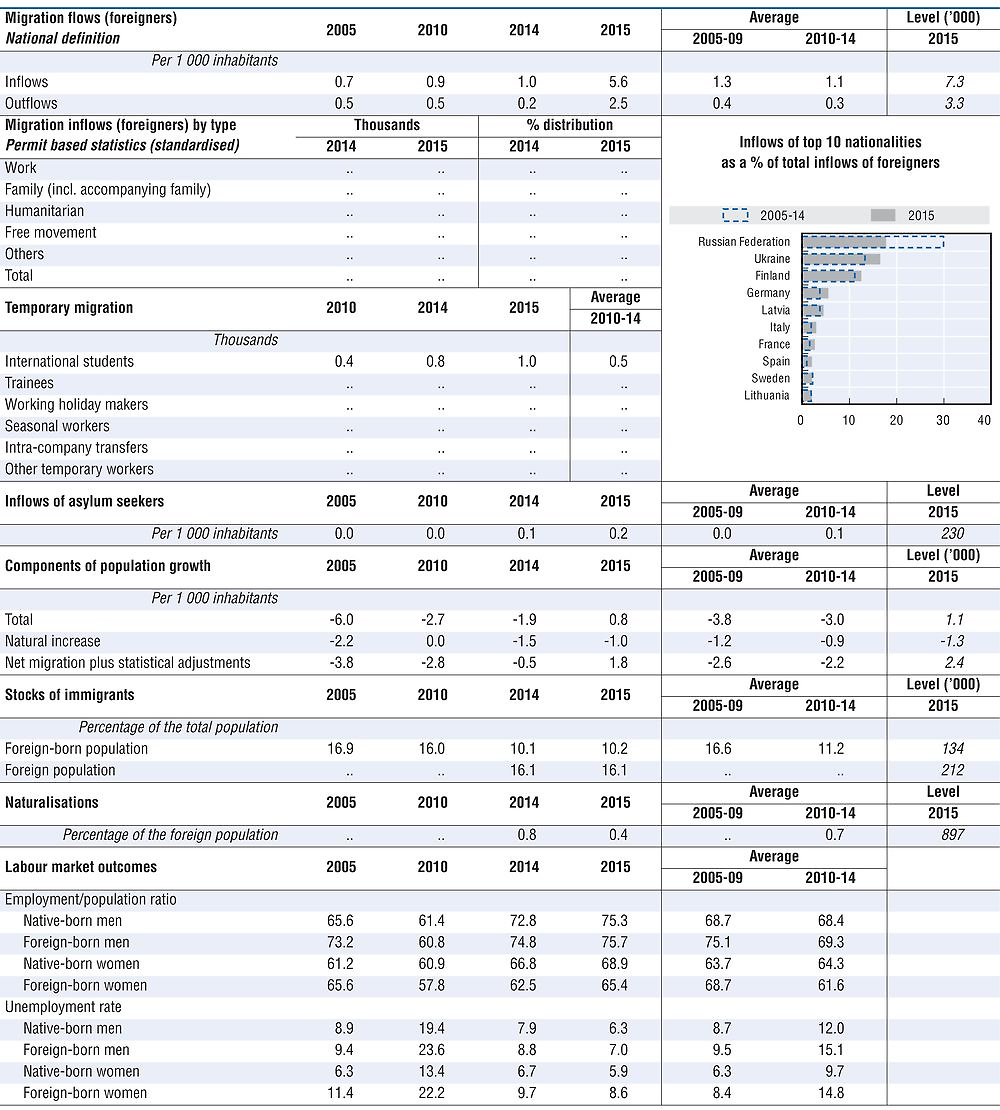Estonia
The Estonian population was estimated at 1.31 million in 2016 (0.3% decline on the previous year), of which 16% were foreign. The vast majority of foreigners are long-standing migrants who came from different parts of the Soviet Union prior to 1991, and their descendants.
Statistics Estonia calculates external migration based on the residency: a person transitioning from resident to non-resident is an emigrant and the opposite is an immigrant. Migration flows have increased. A total of 15 400 persons immigrated to Estonia and more than 13 000 persons emigrated from Estonia in 2015. The resulting net inflow of about 2 400 people contrasts with the net loss of 730 in the previous year. Estonian citizens accounted for 52% of immigrants and 69% of emigrants. Nationals of EU countries made up 21% of immigrants and third-country nationals 27%. There was a 48% increase in the number of residence permits issued and renewed for Ukrainians in 2015, following the events there, with increases also for citizens of Nigeria (+85%), Belarus (+13%) and Russia (+11%).
The main destination country for emigrants was again Finland with close to 2 700 Estonian emigrants going there. Other main destination countries were the United Kingdom and Germany, as well as Ukraine and Russia. Around 15% of the emigrants were EU citizens and 10% were of other citizenship.
In 2015, 4 900 (+21% compared to 2014) temporary residence permits were issued to foreigners (including status changes from one category to another) and 6 400 (+34%) temporary residence permits were extended. While in 2014 the biggest category of persons granted temporary residence permits had applied for family reunification, in 2015, the biggest category was labour migration (34%). The number of persons granted residence permits for studies went up by 28%. The number of extensions grew in 2015 because a large number of residence permits, granted for the duration of five years and mainly issued on the basis of a treaty or for studies, expired.
Estonia receives few asylum seekers, but the number is growing, as is the share of terminated proceedings – mostly due to asylum applicants from Ukraine who waived their applications. Out of 230 asylum applications in 2015, international protection was granted to 80 people, five times more than 2014. The increase is particularly due to Ukrainians (40% of asylum seekers). During the first eight months in 2016, 60 persons received refugee status (20 of them under the European Migration Plan) and 50 subsidiary protection (30 of them under the European Migration Plan).
In 2016, the terms for obtaining a long-term residence permit were simplified. Permanent residence permits may be granted to foreigners who settled to Estonia before July 1990 and who have been living in Estonia and do not harm the interests of the state.
Amendments to the Aliens Act are designed to raise economic competitiveness and ensure a qualified workforce. New amendments taking effect in 2016 and 2017 include the creation of a temporary residence permit granted for five years and extended by ten years, as well as the extension of the short-term employment period, from 180 days to 270 days per annum. In addition, new categories of immigrants are given the right to engage in short-term employment, notably persons staying in Estonia after the expiration of their residence permit for the duration of 90 or 183 days. From January 2016, a foreigner who comes to work in Estonia may now simultaneously work for several employers, if work-related provisions comply with the residence permit. The obligation for aliens to register with the Police and Border Guard Board if they leave Estonia for more than 183 days has been cancelled.
The range of categories of persons not subject to quotas – adding the categories of IT sector workers and applicants of residence permits for the purpose of start-up entrepreneurship – has been extended. A new basis for applying for a residence permit was also introduced for large-scale investors, who have made an investment worth at least EUR 1 million.
Estonian naturalisation policy is to decrease the number of persons with undetermined citizenship residing permanently in Estonia. The number fell by about 2 800 persons (3%) in 2015, from 88 100 to 85 300. In 2015, 82% of those who acquired Estonian nationality were persons with undetermined citizenship.

